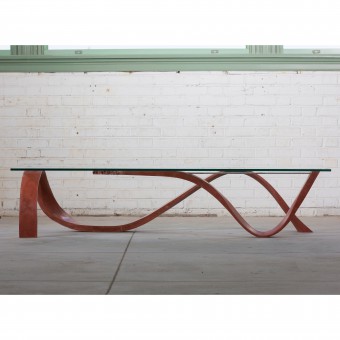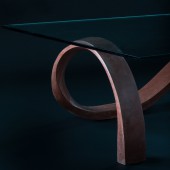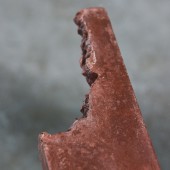
| THE AWARD |
| CATEGORIES |
| REGISTRATION |
| SUBMIT YOUR WORK |
| ENTRY INSTRUCTIONS |
| TERMS & CONDITIONS |
| PUBLICATIONS |
| DATES & FEES |
| METHODOLOGY |
| CONTACT |
| WINNERS |
| PRESS ROOM |
| GET INVOLVED |
| DESIGN PRIZE |
| DESIGN STORE |
| THE AWARD | JURY | CATEGORIES | REGISTRATION | PRESS | WINNERS | PUBLICATIONS | ENTRY INSTRUCTIONS |
Stasis Coffee Table by Mike Pond |
Home > Winners > Design #42665 >Interview |
 |
|
FS: What is the main principle, idea and inspiration behind your design?
MP: To explore and celebrate the capabilities of concrete. Hopefully to create a pristine, slender object from a material normally associated with mass and roughness.
FS: What has been your main focus in designing this work? Especially what did you want to achieve?
MP: I hoped in many ways for it to be a reminder that as technology continues to advance our materials and change the way we approach functional design, that we don’t lose sight of what we love about the material to begin with. Concrete has some special and unique characteristics that make it different from every other material, but we tend to use it like plastic, or granite. I hope the table will serve as a reminder to love materials also, not just shapes or space.
FS: What are your future plans for this award winning design?
MP: I'm not sure, I would love to sell more of them, I think its a wonderful table, but I hope primarily to continue to explore the potential of concrete and other materials.
FS: How long did it take you to design this particular concept?
MP: Well, its only a few lines, so not very long to design. Once I had the picture of it in my head, I think maybe 30 seconds to draw it on a piece of paper. It took quite a bit more time and experimenting to learn how to be sculpt the molds so as to be able to achieve the shape I saw in my head.
FS: Why did you design this particular concept? Was this design commissioned or did you decide to pursuit an inspiration?
MP: This began really as something I saw in my head, while thinking about molding opportunities. i couldn't figure out how to "flip" the mold and essentially pour concrete upside down. I guess I couldn't let that idea go, so i kept toying with it until this was produced.
FS: Is your design being produced or used by another company, or do you plan to sell or lease the production rights or do you intent to produce your work yourself?
MP: This is my own private design. I would certainly entertain an offer as to how this was produced and sell the rights accordingly, but as of right now I simply produce them independently.
FS: What made you design this particular type of work?
MP: The impetus was that I was honestly trying to think of how to "pour" concrete upside down. This is the result.
FS: Where there any other designs and/or designers that helped the influence the design of your work?
MP: Sure, in the sense that we are always (hopefully) influenced by our peers and leaders of the industry, but this particular design began 100% in my head, and changed only slightly from its inception to execution.
FS: Who is the target customer for his design?
MP: I would think that any collector that likes provocative furniture pieces would be interested in the Stasis Table. It is not cheap to produce them so I can’t sell them inexpensively, which narrows the target quite a bit in terms of customer base.
FS: What sets this design apart from other similar or resembling concepts?
MP: As near as I can tell, there are no resembling concepts. Certainly not from concrete, so I suppose that is the best answer to the question. The fact that this is being produced from a material largely associated with mass as opposed to grace, namely concrete, would set this apart.
FS: How did you come up with the name for this design? What does it mean?
MP: Stasis means “balance”. It is one of the roots in the word “homeostasis”, which is used to describe when a system is in balance with itself. That concept is very descriptive of the Stasis Table, as the individual elements are balanced themselves, as well in balance as a unit.
FS: Which design tools did you use when you were working on this project?
MP: Just a pencil, as far as the conceptual phase. Once I began fabricating it, I used standard wood and concrete working tools.
FS: What is the most unique aspect of your design?
MP: I think that the shapes are quite lovely in and of themselves. They're sensual and confident, I am very pleased with how they look. I think that when it is discovered by an observer that it is fabricated from concrete, the Stasis Table really takes on a whole new definition in people's minds.
FS: Who did you collaborate with for this design? Did you work with people with technical / specialized skills?
MP: No collaborations in the sense that outside companies or specialists were involved, but I certainly have people I work with within the construct of Solid and Void, namely Scott Soffer whom I have worked with for well over a decade. Scott is a carpenter and designer in his own right and he and I work very well together.
FS: What is the role of technology in this particular design?
MP: No particular technology in terms of computer programs or anything like that, but absolutely in terms of concrete advances. This type of project wouldn’t have been plausible even a few years ago, but with the modifier and fiberglass additives in concrete, a strength of 10,000 psi (compression) and a tensile strength of up to 3000 psi can be acheived. This reduces (or in this case, eliminates) the need for buried steel reinforcing, which would’ve been inordinately difficult to shape in a case like the Stasis Table.
FS: Is your design influenced by data or analytical research in any way? What kind of research did you conduct for making this design?
MP: Yes, but not in the way you might be thinking. I spend a lot of time with a job like this experimenting. So they saying goes “close enough isn’t good enough for mathematics, but is for engineering”. So I don’t spend too much energy on math that is probably out of my league anyways, as much as I do trying something, breaking it, observing how it breaks, try again. I’ll continue to load something more and more until it achieves the strength I am looking for. I ultimately found the solutions to things I was looking for through deformation of what is otherwise a simple shape. The table is really just a few lines, so coercing those lines to distribute the weight properly was the challenge. In the case of the Stasis Table, I really wasn’t satisfied until it could hold my full body weight and about 100 pounds of glass.
FS: What are some of the challenges you faced during the design/realization of your concept?
MP: Creating a shape that was strong enough to be functional, while maintaining a slender and elegant look. It couldn’t be clumsy.
FS: How did you decide to submit your design to an international design competition?
MP: I felt like I had a good product. I haven’t seen many products like it, and so I researched what would give it the exposure I felt was warranted, and proceeded from there.
FS: What did you learn or how did you improve yourself during the designing of this work?
MP: I would think it was more a result of learning and improving 1,000 different ways prior to beginning this. 10 years ago I wouldn’t have been able to produce this, because I didn’t have the patience for it yet.
FS: Any other things you would like to cover that have not been covered in these questions?
MP: Yes, actually. I would like to call attention to the prominence that the CNC router has taken in the design and fabrication industry in the last decade. I think it is a wonderful tool and I applaud its use the same as I would a hammer or a computer or anything other device that can help get good designs finished. However, I believe that the dependence on this tool has led to a diminished appreciation and love for the intrinsic characteristics of materials. I am most definitely NOT calling for the disuse of the CNC router but I am calling attention to the fact that this tool has allowed all manner of materials to be treated as plastic, where nearly any Euclidian shape can carved into nearly any material, for either the finished product of the form. This can lead to terrific advancement in design possibilities, but it can also lead to us as designers merely thinking in terms of SHAPE, not in terms of both shape and material. I would like to always remind ourselves to love one species of wood more than another, love what makes concrete so beautiful when it is broken, or polished or grinded. To just remember to always love materials also.
FS: Thank you for providing us with this opportunity to interview you.
A' Design Award and Competitions grants rights to press members and bloggers to use parts of this interview. This interview is provided as it is; DesignPRWire and A' Design Award and Competitions cannot be held responsible for the answers given by participating designers.
| SOCIAL |
| + Add to Likes / Favorites | Send to My Email | Comment | View Press-Release |




